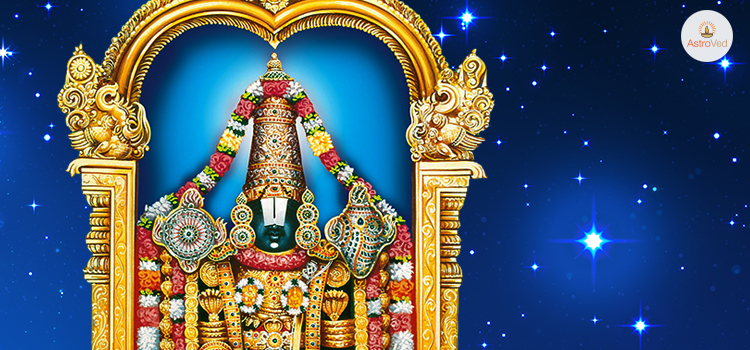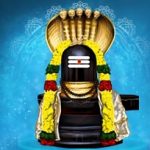Purattasi Sani
The Tamil month Purattasi is a highly Sacred month meant for worships and religious activities. This 6th month of the Tamil calendar extends from mid-September to mid-October and is dedicated to worshiping Vishnu, the Supreme God of Protection and Sustenance, and particularly Venkateshwara, also called Srinivasa, Venkatesa, or Balaji, the Lord of the famous hill Temple Tirupati. Also, during Purattasi, the Sun is transiting sign Virgo, ruled by planet Mercury, whose overlord is Vishnu.
Besides, according to legends, Vishnu descended on earth in human form as Venkateshwara only during Purattasi, whereas the weekday Saturday (called ‘Sani’ in Tamil) remains particularly holy for Venkateshwara worship. Hence, Purattasi Saturdays are special for Venkateshwara worship, when many also observe Purattasi Sani Viratham.

Lord Venkateshwara
Venkateshwara, the Vishnu aspect, is the Supreme Lord of immense wealth and abundance, who also remains the ultimate refuge of the devotees and the provider of boons during the present epoch of Kali Yuga. The auspicious Purattasi month, especially the Purattasi Saturdays, remains the most propitious occasion to connect with him deeply and receive his benevolent blessings to get rid of financial distress, debts, sufferings, and inauspiciousness, earn wealth, enjoy abundance, material prosperity, pleasures, well-being, and fame, and move towards spiritual enlightenment.
Moreover, invoking Vishnu during Purattasi Saturdays can mitigate the adverse effects of the much-feared planet Saturn, reduce its delaying impacts, and help people advance and achieve in all facets of life.
Purattasi Sani Viratham
Hence, it is a tradition and practice from ancient times for devotees to dedicate Purattasi for worships, prayers, and rituals when they refrain from consuming non-vegetarian food, liquor, etc., observe austerities like fasting, and devote time to devotional activities.
Purattasi Sani Viratham is one such austerity people observe on Purattasi Saturdays when they do a fasting and offer worship to Lord Venkateshwara, seeking his Divine grace.
Purattasi Sani Viratham Pooja Procedure
Here, we will see in brief the simple guidelines for the devotees to observe Purattasi Sani Viratham, Pooja, and worship.
Take an image or picture of Lord Venkateshwara, clean it, apply sandal paste and kumkum, and decorate it with a silk cloth and flowers.
Clean and prepare a Sacred vessel, a metallic pot made preferably of silver, copper, or brass, and consecrate it for ritualistic worship by drawing the markings of the deity on it like the Naamam, the prominent mark on the Lord’s forehead,
conch and discus, which he holds in his hands, preferably with rice flour.
Devotees can prepare Maavilakku Maavu, a unique Purattasi Saturday sweet delicacy made principally of rice flour, jaggery, and ghee as a primary oblation for Purattasi Sani Pooja. They can also make mixed-rice varieties like coconut rice, tamarind rice, sesame seed rice, curd rice, and Vada varieties and offer these as oblations to Lord Venkateshwara. They can place small quantities of these oblations on a banana leaf spread in front of the pot or on a clean plate. They can also make offerings of betel leaves, areca nuts, coconut, and fruits to the deity.
Identify the auspicious time for performing that Day’s Pooja and rituals after staying clear of the inauspicious periods like Rahu Kalam and Yamagandam.
They can light traditional oil lamps for Pooja, along with incense sticks.
Then, make a hollow at the top of the heap of Maavilakku Maavu, add a sufficient quantity of ghee in it, put a wick, and light a lamp in it. This Maavilakku Maavu Deepam remains the specialty of Purattasi Sani Viratham and Pooja.
Recite Mantras and Slokes dedicated to Lord Vishnu, particularly Venkateshwara, the Lord of Tirupathi. Vishnu Sahasranama, containing the 1000 Sacred names of Vishnu, is a highly blessed hymn; reading, chanting, or even listening to this hymn during this Pooja can be highly auspicious and get the compassionate blessings of the merciful Lord to the devotees. They can also do Archana, the light and sound worship, using Tulsi, the holy basil leaves, which Vishnu is believed to be very fond of.
Then, people can offer oblations to the Lord and conclude the Pooja by performing the Arti worship waving the lighted camphor before the deity.
Devotees can observe Viratham, the fasting on Purattasi Saturdays, and conclude this Purattasi Sani Viratham after finishing the Pooja by accepting the holy Prasad.
Let us also observe Purattasi Sani Viratham and offer worship to Venkateshwara with devotion and faith for his benevolent grace for a good life.

